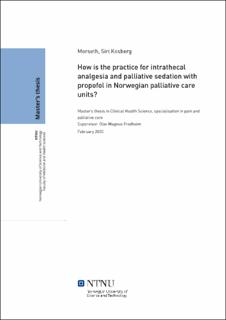| dc.contributor.advisor | Fredheim, Olav Magnus | |
| dc.contributor.author | Morseth, Siri Kosberg | |
| dc.date.accessioned | 2020-06-04T16:01:00Z | |
| dc.date.available | 2020-06-04T16:01:00Z | |
| dc.date.issued | 2020 | |
| dc.identifier.uri | https://hdl.handle.net/11250/2656650 | |
| dc.description.abstract | Bakgrunn: Smerte er et dominerende symptom for mange pasienter med langtkommet kreftsykdom. Intratekal smertelindring kan vise seg å være løsningen for pasienter med smerter som ikke lar seg lindre med standard smertebehandling. I tilfeller hvor smerte eller andre symptomer i terminalfasen er refraktære for standard behandling, kan palliativ sedasjon være et alternativ. Det anestetiske legemidlet propofol har blitt foreslått til bruk i den sammenheng, når man ikke kommer i mål med andre sedativa. Hensikt: Hensikten med studien var å kartlegge bruken av intratekal analgesi og palliativ sedasjon med propofol i norske palliative enheter, og sammenligne disse med internasjonal forskningslitteratur. Metode: Informasjonen om praksis for disse to avanserte anestesiologiske behandlingsformene i norske sykehus har blitt samlet direkte fra enhetene gjennom et spørreskjema. Et grundig søk i internasjonale forskningsdatabaser ble utført for å finne akutell litteratur. Resultater og konklusjon: De fleste palliative enhetene kan tilby sine pasienter intratekal smertelindring og omtrent en tredel av enhetene har utført palliativ sedasjon med propofol i løpet av de siste to år. Forskjeller er funnet i hyppighet, valg av medikamenter og monitorering av pasienten. Totalt sett er antallet pasienter som mottar begge disse behandlingene lavt, som mulig kan være en indikasjon på at flere kunne hatt nytte av disse anestesiologiske behandlingene. Variasjonene omkring praksisen for intratekal analgesi og palliativ sedasjon med propofol viser et behov for ny forskning for å etablere høyere evidens. | |
| dc.description.abstract | Background: Pain is a predominant symptom for many patients with advanced stage cancer, and present in almost everyone towards the end of their life. Intrathecal administration of analgesics may provide a feasible option for patients who experience pain so severe it is intractable to standard analgesic regimens. In cases where pain or other symptoms towards the end of life are so severe that they are refractory to standard treatments, palliative sedation may be warranted. The anaesthetic agent propofol has been proposed as a last resort for this purpose when other agents fail to provide relief. Purpose: The aim of this study was to map the practice for intrathecal analgesia and palliative sedation with propofol in Norwegian palliative care units and compare findings to research literature available. Material and methods: Information about the practise for these two advanced anaesthesiologic treatment modalities were collected through a questionnaire directly from the palliative care units. An extensive search in scientific databases was carried out to find research literature. Results and conclusion: Most hospitals can offer their patients intrathecal pain treatment and about a third of the units have carried out palliative sedation with propofol within the last two years. Variances are found in frequency, choice of medications and monitoring of the patient. The total number of patients receiving these treatments are low, possibly indicating that more patients could have benefited from these anaesthesiologic methods. The variances in practice surrounding intrathecal analgesia and palliative sedation with propofol portray a need for further studies to establish better evidence. | |
| dc.language | eng | |
| dc.publisher | NTNU | |
| dc.title | How is the practice for intrathecal analgesia and palliative sedation with propofol in Norwegian palliative care units? | |
| dc.type | Master thesis | |
